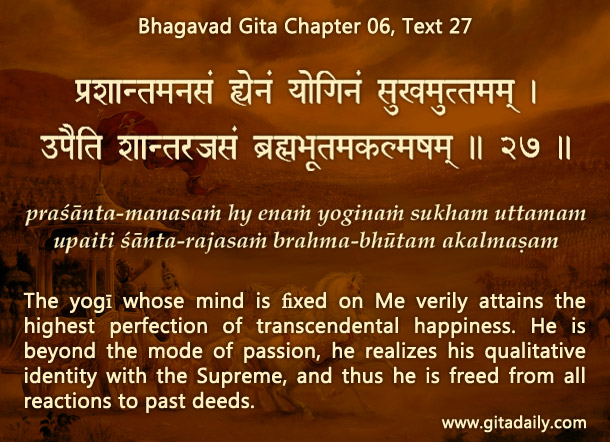
Just as stormy winds sweep a boat away, the Bhagavad-gita (02.67) states that the winds of sensual desires sweep us away from the spiritual path.
Taking the wind out of something refers metaphorically to taking away its activating energy, thereby stopping it. To take the wind out of the mind, we need to cut off the energy source that activates and agitates it. That source is the mode of passion, which powers the mind by presenting alluring sense objects externally and triggering material desires internally.
Meditation involves drawing the mind away from worldly objects and fixing it on a dispassionate focus point. Initially that point may be something material such as the space between the eyebrows (05.27) or the tip of the nose (06.13), but subsequently it needs to be the supreme spiritual reality, Krishna (06.14).
Meditation on Krishna doesn’t just stop the wind of passion; it also activates the wind of devotion.
Why is Krishna the best object of meditation?
Because he is the all-attractive reservoir of all pleasure. So, meditation on him provides a deep satisfaction that makes it easier to withdraw from the outer gratification promised by passion. Of course, the wind of passion can and does distract us from meditating on him. But such distraction won’t make us discouraged (06.24: anirvinna-cetasa) if we strive to meditate with determination and keep bringing the mind back to Krishna.
By such steady practice, our Krishna-connection becomes stronger and sweeter, thereby providing greater satisfaction and eventually causing the wind of passion to fall silent, as the Gita (06.27: shanta-rajasam) indicates.
In fact, meditation on Krishna doesn’t just stop the wind of passion. It also activates the wind of devotion that pushes our mind towards him. The zenith of this devotion is exemplified in the gopis of Vrindavan who couldn’t forget him even when they tried to. Such spontaneous absorption in Krishna is life’s supreme perfection.


HARI BOL !
Hare Krishna Prabhuji
PAMHO
In Bhagavad Gita 06.35, Lord Sri Krishna says to Arjuna: “O mighty-armed son of Kunti, it is undoubtedly very difficult to curb the restless mind, but it is possible by suitable practice and by detachment.”
Thank you very much for the wonderful hints towards developing such practice.
Hari Bol.
Narottama das